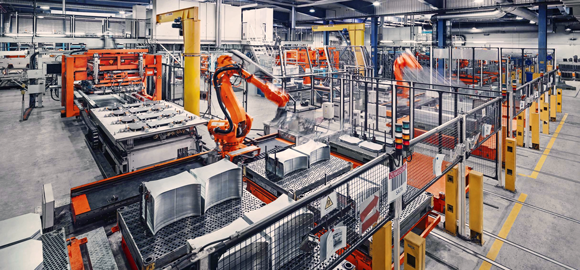Rise of electromobility not a threat to steel demand, finds study
March 27, 2019

Automotive component production at voestalpine’s plant in Linz, Austria (Courtesy voestalpine AG)
During the Handelsblatt Annual Conference on the future of steel, held in Düsseldorf, Germany, March 20–21, 2019, the Handelsblatt Research Institute (HRI) presented a new study, commissioned by voestalpine AG, Linz, Austria, on the role of steel in electromobility. The study found that, although the trend toward lightweighting in automotive construction has enabled materials such as aluminium and plastic to become established in the automotive industry, the demand for steel is predicted to remain high or possibly increase as the automotive industry continues to change.
The study was based on secondary analysis of eighty sources, as well as interviews with six experts. Among its conclusions, it found that the electromobility sector will rely on an intelligent mix of materials in which steel will continue to play a crucial role. Moreover, it was speculated that the trend in electric vehicle development of reducing weight “at any price” is now coming to an end; while carbon-fibre reinforced plastics, for example, are lighter and tougher than steel, they are also significantly more expensive and harder to recycle, giving steel a cost and ecological advantage.
It was stated that steel’s advantage could be boosted further by the development of new high- and ultra-high tensile steel grades, which will allow steel to remain a competitive material for electric vehicle production in the long-term. High- and ultra-high tensile steel grades can be lightweight and tough, and steel is also comparatively easy to process and recycle.
Jan Kleibrink, Head of Economic Analysis at the Handelsblatt Research Institute, stated, “There are not only economic reasons for using steel in electromobility, but also comparatively good life cycle assessment and safety aspects.”
The study drew on current market and vehicle production data to surmise its picture of the future for steel in the automotive industry, finding that several automotive manufacturers have near-term plans for vehicle construction in which steel continues to play a key role. It was found that the BMW i5 model will be constructed in steel and light alloys from 2021, a shift from the carbon used in the i3.
In the Tesla model 3, the share of aluminium and titanium will be reduced in favour of steel. “The share of high-strength steels amongst the steel grades used in vehicle construction will rise from its current level of 18% to 30%,” explained Kleibrink, citing preliminary work by the Posco Research Institute. According to the World Steel Association, this would allow vehicle weights to be reduced by between 25–39%, leading to potential savings of 3–4.5 tons of greenhouse gas emissions over a vehicle’s service life.
The study found that steel also plays a crucial role in the motor and drive of electric vehicles, with between 40 and 100 kilos of non-grain-oriented electrical steel reported to be used in the construction of purely electric vehicles. It was speculated that this could increase demand for this magnetically-soft material to over a million tons a year in Europe, depending on demand.
Steel manufacturers were said to be focusing the development of thinner, tougher electrical steels in order to reduce the weight of the motor. However, as the physical limits in this field are believed to have almost been reached, it is thought that in future manufacturers will differentiate themselves primarily through their expertise in bonding, joining and forming technologies.
In addition, special alloys with a higher silicon and aluminium content are capable of reducing heat loss in the motor during magnetic reversal by up to 30%. Manufacturers with expertise in this segment are expected to benefit from the growing electromobility market.
By 2025, it was estimated that over 14 million electric vehicles may have been sold in the EU alone. According to the study, this is a trend in which steel as a material will play an important role, as the dominant ingredient in an intelligent materials mix designed to maximise cost efficiency, sustainability, and safety.















